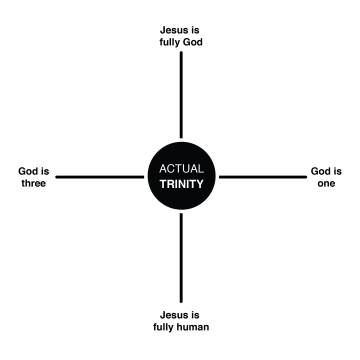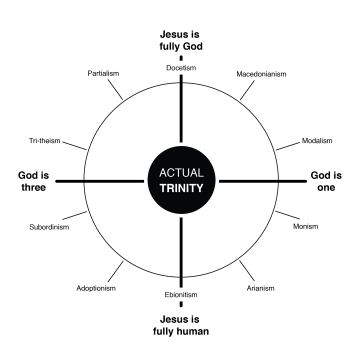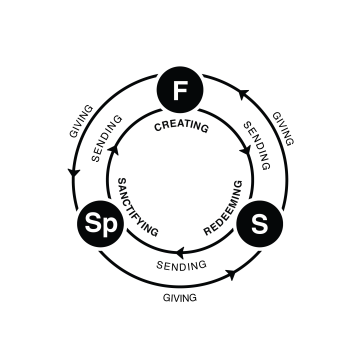
Many Christians think that the Trinity is confusing, contradictory, and impractical.
Isn’t that a shame?
The Trinity is not only who God is, but also what makes Christianity compelling among the world’s religions.
However, making the Trinity more relevant in evangelism and discipleship requires an embrace of paradox rather than the customary retreat from it.
The paradox of three persons in one being should be joined by another paradox, that of Jesus being fully human and fully God. We like to keep these paradoxes separate and for good reasons. But it’s better to let the paradoxes define each other, for they are intrinsically linked in the person of Jesus. If we plot them together on perpendicular axes, we get this picture:
While many of us would never say that Jesus is not God, we often don’t fully believe that Jesus really is God.
The same often goes for his humanity. Sadly, this makes the Trinity a mere decoration, with a distant Father as God alone, with the effect that the revelation of the Son in Christ Jesus is often superseded by other ideas.
And the indwelling of the Spirit is often ignored.
Embracing the double paradox helps Jesus, the Trinity, and other aspects of our faith make sense. Rejecting them results in what I call the “outer rim of misunderstanding.” Here is the above picture with the rim of misunderstanding drawn in:
You can look up these “outer rim” views if you are unfamiliar with them. You may even be partial to one. They each overemphasize one aspect of God at the expense of others. Each has been rejected by the Church throughout history. But we can all find ourselves falling onto the rim from time to time. The illustration is a good diagnostic to see if we are on target in sighting the actual Trinity that Jesus reveals. And it helps us recalibrate, if necessary.
The Trinity is mysterious, but not unknowable, for it reveals that God is personal, self-sacrificing love, and that the image of this invisible God is Jesus.
We most clearly see the Trinity at work in the ministry of Jesus. But we are mistaken if we think the snapshot of the human Jesus interacting with the Father and Spirit is the total view that the Bible gives us. The Son and Spirit are co-equal and co-eternal with the Father. And the unified work of all three can be seen in Scripture from creation through to the end of time.
Imagine with me how the Trinity has interacted throughout time, using God’s Word as a guide.
1. Eternity
Imagine a God who exists eternally as a community of three equally divine persons. The relational communion of the three is so perfect that they are one divine being. And this one relational God is love. This love is dynamic — open to experience, to giving and receiving. Each divine person exists in and through this love. Each pours himself out sacrificially on behalf of the other two, even as he is filled by the other two. The one is constituted by the three, while the three is constituted by the one. This is called perichoresis, the eternal dance of love.
2. Creation
Now imagine that God chooses to extend this love beyond Godself, to overflow it into something new. So God creates the universe. In an act of self-limitation and sacrifice, God pulls back to make room for something other than God. The Spirit takes the lead in the eternal dance and hovers over the primordial “waters” of this void. The Spirit then pours himself out into the Father and the Son as he does in eternity and extends it to the world, overflowing the eternal dance of love into Creation. Through his self-emptying, the Spirit sends the Father as Creator and gives divine power over our creation to the Son, through whom all things are created.
And it was good.
And imagine that God said, “Let us make humankind in our image, according to our likeness” (Gen. 1:26). Male and female, individuals created in the image of the one God, yet together created in the image of the communal God who exists through interpersonal relationships.
And it was very good.
Yet there were bound to be problems for a Creator who is love. For love requires persons who are free to accept or to reject their part in the dance. Persons who are free to choose for or against relationship. And so the relational barrier of sin infects and separates humanity from God. Yet from eternity the Trinity had chosen a solution to our problem. A solution with a great cost.
3. Redemption
Imagine that the Father takes the lead in the eternal dance. Reciprocating the work of the Spirit, he pours himself out into the Son and Spirit as he does in eternity and extends it to the world, the dance of love overflowing. In self-emptying, the Father sends the Son as Redeemer and gives divine power over our redemption to the Spirit. The Son temporarily gives up his divine privileges and becomes fully human, more human than you or me, for he knows no sin. God submits to becoming a part of creation.
Yet God cannot stop being God.
Fully God and fully human exist perfectly and paradoxically together in the person of Jesus. For God makes space within eternity for humanity, the perfect humanity of Jesus Christ. In him, God is perfectly represented for us, and the character of God is fully seen. Now watch how sin and its curse — our suffering, alienation, even death itself — is taken upon by Jesus on the cross, causing him to experience a loss of communion with the Father and the Spirit. And in that moment, Jesus dies. The dance stops abruptly.
It is hard to imagine. On the cross, the Father and the Spirit painfully forsake Jesus, letting go of their beloved for the first time, for sin has no part in the dance of love. Is the being of God broken when the three divine persons suffer the loss of communion? Jesus has poured himself out for us all, taking on our sin, dying. What is the Trinity to do when Jesus dies? What they always do and had purposed to do all along — they dance.
For while Jesus suffers death, it has no power over him. Rather than losing Jesus to sin and death when they let him go, in their being that cannot be broken they reach past him. In Jesus, the Father and the Spirit reach beyond our sin and through death itself to the very core of darkness. And there, Father and Spirit find Jesus, who falls in complete trust into their embrace. And there, in the redeemed humanity of Jesus on the other side of death, God also finds us. And Father, Son, and Holy Spirit dance, this time on both sides of the sin barrier, within and beyond, and this dance shatters sin and death, raising Jesus from the dead.
4. Sanctification
Imagine now that the risen Son reciprocates, taking the lead in the eternal dance. He pours himself out into the Spirit and the Father, as he does in eternity and extends it to the world, the dance of love overflowing. In doing so he sends the Spirit as our Restorer and gives divine power over our restoration to the Father. The Spirit is active in our hearts and, indeed, throughout the world, sanctifying it for Jesus’ return. And the Father — who governs and chooses the day of final restoration — works, and waits, and loves.
And soon the day will come when time and space will be folded into eternity. For those who say yes to God, the dance draws us in. For in Jesus — who holds both divine and human, eternal and temporal, heaven and Earth, perfectly and paradoxically together — the dance has been extended to you and to me. Jesus reaches out his hand and asks you to follow him, desiring you to join this eternal movement of love, or what he simply calls eternal life.
The above picture illustrates this eternal movement of reciprocal love that overflows into the world through God’s creating, redeeming, and sanctifying. This Trinitarian view is often compelling for believers and unbelievers alike. Yet the Trinity is the Christian perspective not because it is newly hip or interesting, but precisely because it is Christ’s own perspective. His life and teaching is centered on the reality of his oneness with the Father and the Spirit. His humanity exists perfectly along with his divinity. The eternal life that we preach to the world is simply the overflow of the love that Father, Son, and Holy Spirit share. Our discipleship is simply submitting to the dance of self-giving love that the Trinity embodies. And paradox is integral to this abundant life in God, for as Jesus says,
Whoever would save his life will lose it, yet whoever loses his life for my sake, will save it.
Luke 9:24






